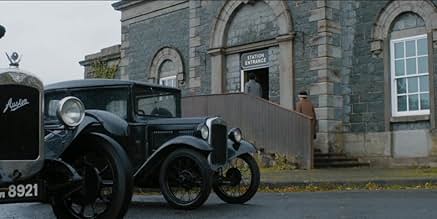In 1926, with her personal life in tatters and her writing in crisis, a young Agatha Christie decides to solve a real-life murder.In 1926, with her personal life in tatters and her writing in crisis, a young Agatha Christie decides to solve a real-life murder.In 1926, with her personal life in tatters and her writing in crisis, a young Agatha Christie decides to solve a real-life murder.
- Rosalind
- (as Amelia Rose Dell)
- Franklin
- (as Joshua Silver)
- Director
- Writer
- All cast & crew
- Production, box office & more at IMDbPro
Storyline
Did you know
- TriviaAgatha uses the under cover name of Mary Westmacott in the drama. The real Agatha Christie published 6 novels under this name between 1930 and 1956: The Rose and the Yew Tree, the Burden, Absent in the Spring, Giant's Bread, Unfinished Portrait and a Daughter's Daughter.
- GoofsThe neck-tie (dark with stripes) that Agatha wears as the legal assistant changes several times during a single scene. The knot may or may present a stripe.
- Quotes
[Sir Arthur Conan Doyle has told Agatha Christie that he once suffered from writer's block and cured it by designing a golf course, and recommends that Agatha should do the same when she asks his advice because her readers are guessing the identity of the culprits in her books. She consults Sir Hugh Persimmion, an expert on golf course design]
Agatha Christie: I want to design a golf course.
Sir Hugh Persimmion: I see. Really?
Agatha Christie: Yes.
Sir Hugh Persimmion: Well, in that case, I'm afraid my answer's quite short. You can't.
Agatha Christie: Excuse me?
Sir Hugh Persimmion: [patronisingly] There isn't a golf club I know that would commission a design from a woman. I understand there has been a trend of late for ladies to golf. But really, the sheer complexity of a designer's task is beyond the capabilities of a woman. No matter how capable that woman is.
Agatha Christie: [smiling ingratiatingly] I see. I hadn't realised. But thinking about it, how could I have been so stupid? Imagine a woman being able to design the preamble to putting something small in a hole. A woman might just present the hole and have done. And where would be the fun in that? There'd be nothing to groom, for a start.
[she stands up]
Agatha Christie: [still smiling sweetly] Thank you for your time. It's been pointless.
[Sir Hugh looks nonplussed as he realises that Agatha's charming "climbdown" and farewell were actually intended to be highly insulting - and highly suggestive as well]
- Crazy creditsDisclaimer in end credits: "This film has not been endorsed, licensed or authorised by the estate of Agatha Christie or by Agatha Christie Limited."
- ConnectionsFollowed by Agatha and the Curse of Ishtar (2019)
The 36-year-old Agatha Christie balances on the verge of a massive depression in 1926. Her husband Archie insists for a divorce, so that he can marry his much younger mistress, and she suffers from a writer's block because her fans always guess the identity of the culprit of her stories via the wrong method. When she's literally begged to help solving the real-life murder of nurse Florence Nightingale, who got brutally bludgeoned to death on a train six years earlier, she sees an opportunity to both escape her personal problems and to perform research and seek inspiration for her work.
The plot isn't exactly plausible, but it's nice to see how the writers attempt to hint at the possible origin of famous Agatha Christie stories that followed after 1926, like the luring of guests to a remote location (And Then There Were None - 1939) and the train settings for "4.50 from Paddington" and "Murder on the Orient Express". The anti-climax actually fits the plot rather well. None of the performances are highly memorable, but the entire cast does their best. You're still better off reading an authentic Christie novel, but "The Truth of Murder" certainly isn't a waste of time.
Details
Box office
- Gross worldwide
- $77,542
- Runtime1 hour 32 minutes
- Color
- Aspect ratio
- 1.85 : 1
Contribute to this page

































